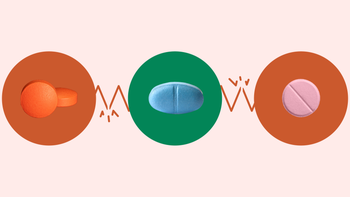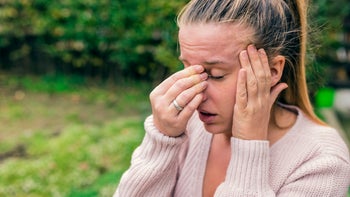
What Is Causing Pain and Soreness on the Roof of My Mouth?
Key takeaways:
Common causes of pain and soreness on the roof of your mouth include health conditions (like oral thrush) and injuries (like cuts and burns).
Depending on the cause, pain and soreness may happen along with other symptoms. Talk with a healthcare professional if you aren’t sure of the cause or if your symptoms hang around for more than a couple of days.
Treatments may include prescription and over-the-counter medications, as well as simple home remedies, such as saltwater gargles and cool fluids.
Table of contents
You probably don’t think much about the roof of your mouth. But when it hurts or feels sore, you’ll become very aware that it’s there. After all, what you eat and drink pass right by it. So, if you’re wondering why the roof of your mouth hurts or feels sensitive, we’ve got you covered. The reality is that a lot of things can cause soreness to the hard and soft palates that make up the roof of your mouth. Sometimes you can probably guess the cause, like a mild burn from a very hot cup of coffee. But other causes can be harder to understand.
Here are common causes of pain and soreness on the roof of your mouth, plus tips on how to treat a sore and irritated mouth.
1. Mouth (canker) sores
Aphthous ulcers (canker sores) are a common cause of pain and soreness in the mouth. These small ulcers can appear on:
Your gums
Tongue
The inside of your cheeks
The roof of your mouth
Save up to 60% on Farxiga
Healthy heart for less. Pay as little as $288 for 30 tablets of Farxiga with GoodRx - no insurance needed.

They look white to yellow in color and tend to be round or oval in shape. Most people just get one at a time. Canker sores can cause pain, burning, and tingling.
Researchers aren’t exactly sure what causes canker sores. But canker sores seem to run in families and involve the immune system. You may get a canker sore after you bite your tongue or cheek, experience stress or hormonal changes, or take medication that lowers your immune system.
A canker sore on the roof of your mouth can make it uncomfortable to eat. So, check out our guide to over-the-counter (OTC) and prescription treatment options for canker sores.
2. Cold sores (fever blisters)
Cold sores are small blisters that the herpes simplex virus (usually HSV-1) causes. They’re very common, so they have several names, including “fever blisters.”
No matter the name, people who get cold sores say they can feel them coming before they see them. It usually involves a tingling or burning sensation around the lips. But cold sores can also appear in other places, including your tongue, nostrils and, you guessed it, the roof of your mouth.
Cold sores tend to occur when your immune system is weakened, like when you’re dealing with an illness or stress. Most cold sores will get better on their own. But there are also herpes treatments that can help you feel better faster.
Who gets oral thrush? This fungal infection of the mouth is more common in babies, but adults can get it, too. Here’s what to do.
Do saltwater gargles actually work? Research shows that gargling with salt water can help relieve pain from a sore throat. Here’s how.
Cold sores can be a pain in the mouth. Cold sores are very common. Three people share what they feel like.
3. Mouth burns
If you burn the roof of your mouth, you’re not alone. Whether you have an encounter with piping hot pizza or freshly brewed coffee or something else, there are lots of ways to accidentally burn your mouth. And a burned roof of the mouth can be quite tender and painful.
Mouth burns tend to heal fairly quickly on their own. You can help the process by quickly cooling down your mouth with cold water. Though it might be tempting, avoid cooling your mouth with ice, since this could cause more damage to your burn. Of course, get medical help if the burn is severe and you have a hard time swallowing.
4. Mouth cuts (trauma)
The roof of your mouth may feel tender and painful due to mouth trauma. Like mouth burns, this can happen from what you eat. For example, you can cut or scratch your mouth by eating foods that are hard or have sharp edges. While your mouth heals, try to stick to soft foods. And avoid acidic things, like coffee and citrus, as these can worsen the stinging and discomfort.
5. Oral thrush
Oral thrush is a yeast infection of the mouth caused by the fungus Candida albicans. Babies and people with a weakened immune system are at highest risk of getting it.
Thrush looks like raised cream or pale-yellow patches (lesions). These can show up on the roof of your mouth and the surrounding area, including your tongue, lips, and throat. These can bleed and cause mouth soreness, cracked lips, and pain when eating or swallowing. Some people also notice a change in their sense of taste.
Oral thrush can go away on its own in babies. But prescription antifungal medications can easily treat it. Thrush can lead to a serious infection in adults, so it’s best to get medical help.
6. Squamous papilloma (warts)
The human papilloma virus (HPV) can cause squamous papillomas (warts) to appear on the roof of the mouth, tongue, and cheeks. These noncancerous warts tend to grow slowly and look like white cauliflower. Usually, these warts are painless and don’t need treatment. But chewing or biting them may lead to irritation and pain.
What other symptoms can you feel besides pain and soreness in the roof of your mouth?
You may have other symptoms at or around the same time as pain in the roof of your mouth. Remember to pay attention to these symptoms.
The type of accompanying symptoms you may have will depend on the specific cause of your soreness and how you respond to the discomfort. For example, burns to your mouth can make it painful to eat or drink, which can lead to dehydration and dry mouth (xerostomia). Petechiae (small red spots) on the roof of the mouth can point to mononucleosis (mono) infection. In addition to a sore throat, mono tends to occur along with a fever, significant tiredness, and swollen lymph nodes. Fever often points to an infection. And, if it lasts more than 3 days, it’s time to get some help.
What does a normal roof of the mouth look like?
Your mouth’s hard palate is toward the front of your mouth. It has ridges and feels firm. Your soft palate (velum) sits toward the back of your mouth, behind the hard palate. It has a soft and fleshy texture and feels somewhat smooth.
For some people, a healthy palate appears reddish pink. For others, the color may look a shade of brown or black. This all depends on how much of the melanin skin pigment your body makes.
What treatments are there for pain in the roof of the mouth?
The pain in the roof of your mouth tends to get better within a few days or weeks without any treatment. This is often the case for minor mouth injuries and sores.
But, sometimes, you’ll need to get treatment. This can mean treating the underlying illness or condition. For example, laser therapy can remove warts from the roof of your mouth.
Treatments for pain and soreness in the roof of the mouth can include:
Pain relievers: This may include medicine for cold sores (such as Abreva) or canker sore medication. Nonsteroidal anti-inflammatory drugs (NSAIDs), like ibuprofen (Advil), can help relieve inflammation and pain.
Medicated mouthwash and oral gels and pastes: These can be helpful for mouth trauma and burns.
Antifungals: These are medications for oral thrush, such as fluconazole (Diflucan).
Steroids: These prescription medications can lessen swelling and boost healing of mouth sores.
Cryotherapy: This is a procedure to freeze growths, such as warts.
Electrosurgery: This uses heat and electric currents to destroy severe cysts and warts.
Which home remedies help ease roof-of-the-mouth pain?
In addition to OTC products to ease pain and swelling, here are some remedies you can try at home:
Mix 1 tsp of salt with ½ cup of warm water. Rinse your mouth with the mixture for 30 seconds before spitting it out.
Gently suck on ice chips.
Apply a piece of ice over the affected area.
Drink healthy fluids (such as water) and eat water-rich foods (such as melons). This helps hydrate your mouth and support overall health.
Cut down or stay away from foods that have too much spice, salt, or acids.
Take small bites of food and chew gently to keep from hurting your palates.
Remember that keeping up with your oral health can go a long way to keeping your mouth feeling clean, healthy, and pain-free.
When should you see a doctor for pain in the roof of your mouth?
There are times when pain in the roof of your mouth needs medical attention. Get medical attention if you experience:
Pain that’s severe, persistent, or worsening
Signs of infection (pain along with fever, swelling, or pus)
Trauma to your mouth that leads to severe bleeding or infection
Fever of 103°F or higher that reoccurs or doesn’t respond to cooling measures, such as taking OTC drugs to bring down your body temperature
Inflamed palates that make it hard for you to breathe or swallow foods or drinks
Oral cancer
The pain you feel in the roof of your mouth may point to a serious health problem. Palate pain that occurs alongside other symptoms may be the sign of oral cancer.
Common symptoms of oral cancer include mouth or lip sores that don’t heal and mouth pain that doesn’t go away. You may also notice other symptoms, such as:
Lumps or growths in your mouth, neck, or throat
Hoarse voice or sore throat that doesn’t improve
A persistent or recurring feeling that something is caught in your throat
Pain or problems with chewing, swallowing, or moving your jaw or tongue
Numbness in areas of the face or throat, such as the lower lip or chin
Red or white patches inside your mouth
Loose teeth or dentures
Ear pain
These may not be present during the early stages of the disease. But if any of these symptoms show up and last for more than 2 weeks, let your primary care provider know right away. Finding and treating cancer as early as possible raises the likelihood of successful treatment and short- and long-term survival.
Frequently asked questions
Some nutritional deficiencies may cause the roof of your mouth to be sore. Not having enough vitamin B12 or folate can cause a kind of anemia called macrocytic anemia. Some people with B12 deficiency have mouth sores or a swollen, painful tongue. If you think you aren’t getting enough of a certain vitamin or mineral, it’s best to schedule an appointment with your primary care provider.
Many things can lead to a sore palate. The time it takes to heal depends on the cause. A minor cut or burn to your mouth, for example, will likely heal pretty fast. Get medical attention if your sore palate is causing you a lot of pain or making it hard to swallow.
Severe dehydration can affect the area around and inside of your mouth. When you’re very dehydrated, your lips and surrounding skin may become cracked. Your tongue and the inside of your mouth may look and feel dry. This dryness may be uncomfortable and cause roof of mouth pain. You should go to the ER if you’re having signs of severe dehydration or persistent roof of mouth pain.
The bottom line
Many things can cause pain and soreness in the roof of your mouth. A lot of the causes are from minor things, like small cuts and canker sores. But there are more serious causes. So, it’s important to pay attention to other symptoms that may occur along with mouth pain and sensitivity.
Usually, you can treat pain on the roof of your mouth with simple at-home remedies, like saltwater rinses, cool fluids, and pain relievers. More serious issues need specific treatments, so check in with a healthcare professional if you aren’t sure or your symptoms last longer than a few days.
Why trust our experts?



References
American Cancer Society. (2021). Signs and symptoms of oral cavity and oropharyngeal cancer.
Baigrie, D., et al. (2023). Electrosurgery. StatPearls.
Centers for Disease Control and Prevention. (2024). About oral health.
Correa, M. E. P., et al. (2019). Systematic review of oral cryotherapy for the management of oral mucositis in cancer patients and clinical practice guidelines. Supportive Care in Cancer.
Darwish, G. (2023). Squamous papilloma of the soft palate: A case report. Cureus.
Helwany, M., et al. (2023). Anatomy, head and neck, palate. StatPearls.
Institute for Quality and Efficiency in Health Care. (2022). Overview: Canker sores (mouth ulcers). National Library of Medicine.
Kaye, K. M. (2023). Infectious mononucleosis. Merck Manual Consumer Version.
Khan, J., et al. (2019). Acute and chronic pain in orofacial trauma patients. Journal of Endodontics.
Kumarswamy, A. (2016). Multimodal management of dental pain with focus on alternative medicine: A novel herbal dental gel. Contemporary Clinical Dentistry.
Moore, C. A., et al. (2025). Macrocytic anemia. StatPearls.
National Cancer Institute. (2021). Mouth and throat problems: Cancer treatment side effects. National Institutes of Health.
National Institute of Dental and Craniofacial Research. (2024). Dry mouth. National Institutes of Health.
National Institute of Dental and Craniofacial Research. (2024). Fever blisters & canker sores. National Institutes of Health.
Slebioda, Z., et al. (2013). Etiopathogenesis of recurrent aphthous stomatitis and the role of immunologic aspects: Literature review. Archivum Immunologiae et Therapiae Experimentalis.
Taylor, M., et al. (2023). Oral candidiasis. StatPearls.
Wong, T., et al. (2020). Common causes of ‘swelling’ in the oral cavity. Australian Journal of General Practice.
World Health Organization. (2024). Herpes simplex virus.

























